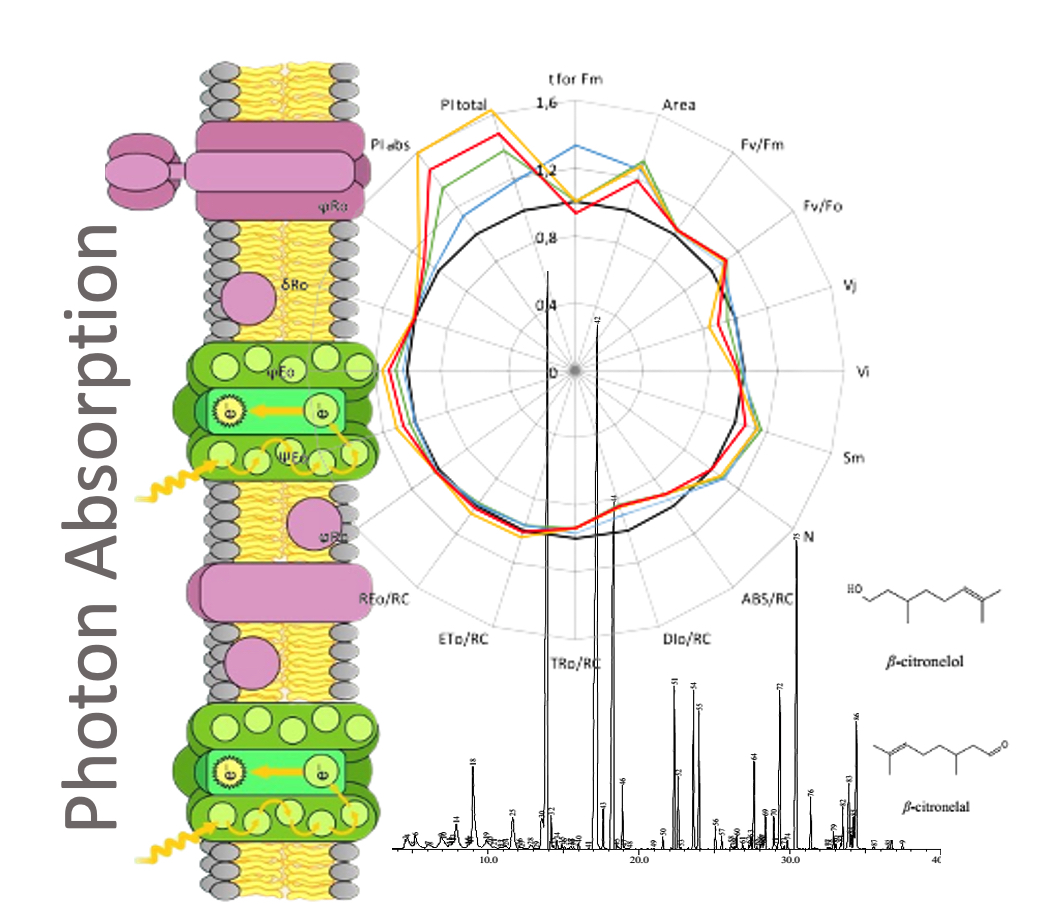Photochemical and essential oil analysis in citronella after cutting of the root system and shoot
DOI:
https://doi.org/10.70151/ckwraq12Keywords:
chlorophyll a fluorescence, pigment content, β-citronelal, β-citronelol, trans-geraniolAbstract
Citronella grass has repellent activity, fungal and bactericidal action due to the action of its essential oil. Thus, the objective was to compare the photochemical capacity with the production of essential oil in citronella plants submitted to different levels of cuts in the aerial part and in the roots. The experiment had a completely randomized design with five treatments (0, 25, 50, 75 and 100%) of cuts in the roots, with 1 cut in the aerial part and 2 cuts in the aerial part, with 4 replicates. Transient OJIP fluorescence assays and chloroplastidic pigments were performed for the different treatments. For extracting the essential oils, the plant material was collected after different dates. For the chlorophyll a fluorescence data on citronella plants after 30 days of root and leaf cut and 165 DAC, all of these treatments remained above the control for the PIabs and PItotal parameters, which reflect the performance index, thus indicating the plants for this period. In relation to the essential oil, the three substances found in the highest proportion were β-citronelal, β-citronelol and trans-geraniol, and the treatment with the highest yield of essential oil did not contain any cuts. Thus, it was verified that for these three substances analyzed there is no need to perform thinning at the root nor cuts in the leaves.
Downloads
References
Adams RP (1995) Identification of essential oil components by gas chromatography/ mass spectroscopy. Ilinois: Allured Publishing Corporation. 469p.
Arnon DI (1949) Copper enzymes in isolated chloroplasts: polyphenoloxydase in Beta vulgaris. Plant Physiol 24(1):1-15. https://doi.org/10.1104/pp.24.1.1.
Bruneton J (1993) Pharmacognosie, phytochimie, plantes médicinales. 2.ed. Paris: Technique et Documentation Lavoisier. 915p.
Castro HG, Barbosa LCA, Leal TCAB, Souza CM, Nazareno AC (2007) Crescimento, teor e composição do óleo essencial de Cymbopogon nardus (L.). Rev Bras Plantas Med 9(4):55-61.
Castro HG, Perini VBM, Santos GR, Leal TCAB (2010) Avaliação do teor e composição do óleo essencial de Cymbopogon nardus (L.) em diferentes épocas de colheita. Rev Ciênc Agron 41(2):308-331.
Corrêa JCR, Salgado HRN (2011) Atividade inseticida das plantas e aplicações: revisão. Rev Bras Plantas Med 13(4):500-506.
Corrêa JCR, Scheffer MC (2013) Boas práticas agrícolas (BPA) de plantas medicinais, aromáticas e condimentares. Instituto Paranaense de Assistência Técnica e Extensão rural – EMATER. 2. ed. Curitiba-PR. 52p.
Dabrowski P, Baczewska AH, Pawluskiewicz B, Paunov M, Alexantrov V, Goltsev V, Kalaji MH (2016) Prompt chlorophyll a fluorescence as a rapid tool for diagnostic changes in PSII structure inhibited by salt stress in perennial ryegrass. J Photochem Photobiol B 157:22-31. https://doi.org/10.1016/j.jphotobiol.2016.02.001
Essemine J, Xiao Y, Qu M, Mi H, Zhu XG (2017) Cyclic electron flow may provide some protection against PSII photoinhibition in rice (Oryza sativa L.) leaves under heat stress. J Plant Physiol 211:138–146. https://doi.org/10.1016/j.jplph.2017.01.007.
Farzadfar S, Zarinkamar F, Hojati M (2017) Magnesium and manganese affect photosynthesis, essential oil composition and phenolic compounds of Tanacetum parthenium. Plant Physiol Biochem 112:207-217. https://doi.org/10.1016/j.plaphy.2017.01.002.
Hendry G, Grime J (1993) Methods in comparative plant. A laboratory manual. Chapman & Hall, London. 252p.
Khayyat S, Roselin LS (2018) Recent progress in photochemical reaction on main components of some essential oils. J Saud Chem Soc 22(7):855-875. https://doi.org/10.1016/j.jscs.2018.01.008.
Lima J, Oliveira U, Silva J, Souza G (2013) Adubação fosfatada e qualidade de luz na produção de biomassa do capim-limão. Encicl biosf 9(16):45-55.
Lima JES, Nascente AS, Leandro WM, Silveira PM (2016) Urochloa ruziziensis responses to sources and doses of urea. Rev Bras Eng Agríc Ambient 20(5):401-407. https://doi.org/10.1590/1807-1929/agriambi.v20n5p401-407.
Mahalwal VS, ALI M (2002) Volatile constituents of Cymbopogon nardus (Linn.) Rendle. Flavour Fragr J 18(1):73-76. https://doi.org/10.1002/ffj.1144.
Martinazzo EG, Ramm A, Bacarin MA (2012) The chlorophyll a fluorescence as an indicator of the temperature stress in the leaves of Prunus persica. Braz J Plant Physiol 24(4):237-246. https://doi.org/10.1590/S1677-04202013005000001.
Rêgo GM, PossamaI E (2004) Avaliação dos Teores de Clorofila no Crescimento de Mudas do Jequitibá-Rosa (Cariniana legalis). Embrapa Florestas, Comunicado Técnico 128.
Rocha HCR, Alvarenga CD, Giustolin TA, Brant RS, Souza MDC, Sarmento HGS, Barbosa MG (2012) Crescimento, produção de fitomassa e teor de óleo essencial de folhas de capim citronela (Cymbopogon nardus (L.) Rendle) em cultivo consorciado com algodoeiro colorido no semiárido mineiro. Rev Bras Plantas Med 14:138-18. https://doi.org/10.1590/S1516-05722012000500010.
Russo M, Honermeier B (2017) Effect of shading on leaf yield, plant parameters, and essential oil content of lemon balm (Melissa officinalis L.). J Appl Res Med Aromat Plants 7:27-34. https://doi.org/10.1016/j.jarmap.2017.04.003.
Sá FVS, Gheyi HR, Lima GS, Paiva EP, Moreira RCL, Silva LA (2018) Water salinity, nitrogen and phosphorus on photochemical efficiency and growth of west indian cherry. Rev Bras Eng Agríc Ambient 22(3):158-163. https://doi.org/10.1590/1807-1929/agriambi.v22n3p158-163.
Schimpl FC, Ribeiro RV, Pereira L, Rodrigues HS, Mazzafera P (2018) Photochemical responses to abrupt and gradual chilling treatments in eucalyptus species. Theor Exp Plant Physiol 30:9-17. https://doi.org/10.1007/s40626-018-0097-2.
Seixas PTL (2012) Efeito da adubação mineral na produção de biomassa, teor e composição do óleo essencial e fungitoxicidade in vitro do capim-citronela. 89p. Dissertation (Master's - Concentration area in Plant Production), Universidade Federal do Tocantins, Palmas, Brazil.
Silva CMM, Gomes MMAE, Freitas SP (2009) Interferência de herbicidas, associados a um análogo de Brassinosteroide, no aparato fotossintético de mudas de Eucalyptus grandis. Planta Daninha 27(4):789-797. https://doi.org/10.1590/S0100-83582009000400017.
Strasser BJ, Strasser RJ (1995) Measuring fast fluorescence transients to address environmental question: The JIP test. In: MATHIS, P. (Ed.), Photosynthesis: From Light to Biosphere. Dordrecht: Kluwer Academic Publisher. 977–980.
Strasser RJ, TsimillI-Michael M, Srivastava A (2004) Analysis of the chlorophyll a fluorescence transient. In: Papageorgiou, C., Govindjee, (Eds.), Chlorophyll Fluorescence: A Signature of Photosynthesis. Dordrecht: Springer – Verlag. 321-362.

Downloads
Published
Issue
Section
License

This work is licensed under a Creative Commons Attribution-NonCommercial-NoDerivatives 4.0 International License.

